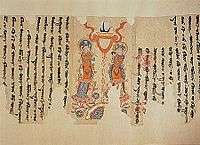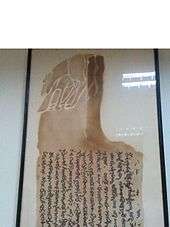Sogdian alphabet
| Sogdian | |
|---|---|
| Type | |
| Languages | Sogdian |
Time period | Late Antiquity |
Parent systems | |
Child systems |
Traditional Mongolian alphabet Manichaean alphabet Old Uyghur alphabet |
The Sogdian alphabet was originally used for the Sogdian language, a language in the Iranian family used by the people of Sogdia.[1] The alphabet is derived from Syriac, the descendant script of the Aramaic alphabet. The Sogdian alphabet is one of three scripts used to write the Sogdian language, the others being the Manichaean alphabet and the Syriac alphabet.[1] It was used throughout Central Asia, from the edge of Iran in the west, to China in the east, from approximately 100–1200 A.D.[1]
Structure

Like the writing systems from which it is descended, the Sogdian writing system can be described as an abjad, but it also displays tendencies towards an alphabet. The script consists of 17 consonants, many of which have alternate forms for initial, middle, and final position.[2] As in the Aramaic alphabet, long vowels were commonly written with matres lectionis, the consonants aleph, yodh and waw.[2] However, unlike Aramaic and most abjads, these consonant signs would also sometimes serve to express the short vowels (which could also sometimes be left unexpressed as in the parent systems).[3] To disambiguate long vowels from short ones, an additional aleph could be written before the sign denoting the long vowel.[3] The alphabet also includes several diacritics, which were used inconsistently. It is written from right to left, but by the time it had evolved into its child system, the Old Uyghur alphabet, it had been rotated 90 degrees, written vertically in columns from left to right.[2] Voiced and voiceless fricatives are consistently not distinguished in the script.[1]
Aramaic logograms also appear in the script, remnants of adapting the Aramaic alphabet to the Sogdian language.[4] These logograms are used mainly for functional words such as pronouns, articles, prepositions, and conjunctions.[1]
Alphabetisation
The Sogdian alphabet was found inscribed in Panjakent, so we can suppose alphabetisation rules - they are the same as in the Aramaic alphabet, but the letter Lāmadh is repeated at the end of the alphabet for values δ, θ.
| Transcription | ˀ | β | γ | d | h | w | z | x | ṭ | y | k | l | m | n | s | ˁ | p | c | q | r | š | t | δ |
| Value | ā̆, ə, ɨ | β, f | γ, x | * | Ø, ā̆ | w, ʷ, ū̆, ō̆, ü, ȫ | z, ž, ẓ̌/δʳ | x | * | y, ī̆, ē̆, ɨ, ə, ǟ | k, g | l | m, ṁ | n, ṁ | s | * | p, b, f | č, ǰ, ts | * | r, ʳ, l | š, ṣ̌/θʳ | t, d | δ, θ |
| Aramaic values | ʔ | B | G | D | H | W | Z | Ḥ | Ṭ | Y | K | L | M | N | S | ʕ | P | Ṣ | Q | R | Š | T | (L) |
* those letters are not used in Sogdian words.
Varieties
Three main varieties of the Sogdian alphabet developed over time: Early Sogdian, an archaic non-cursive type; the sutra script, a calligraphic script used in Sogdian Buddhist scriptures; and the so-called "Uyghur" cursive script (not to be confused with the Old Uyghur alphabet).[1] Early Sogdian dates to the early fourth century C.E., and is characterized by distinct, separated graphemes.[4] The sutra script appears around 500 C.E., while the cursive script develops approximately a century later. The cursive script is thus named because its letters are connected with a base line. Since many letters in the cursive script are extremely similar in form, to the point of being indistinguishable, it is the most difficult to read of the three varieties.[2] As the Sogdian alphabet became more cursive and more stylized, some letters became more difficult to distinguish, or were distinguished only in final position, e.g. n and z.[4]
Source materials
The Sogdian script is known from religious texts of Buddhism, Manichaeism, and Christianity, as well as from secular sources such as letters, coins, and legal documents. The oldest known Sogdian documents are the Ancient Letters, found in 1920 by Sir Aurel Stein in a watchtower near Dunhuang, China.[2] These letters date to approximately 312-313 C.E. and are written in Early Sogdian.[1]
The Sogdian Buddhist texts, written in the sutra script, are younger, dating to approximately the sixth to eighth or ninth century. They were found during the first two decades of the twentieth century in one of the caves of the Thousand Buddhas in the Chinese province of Gansu. The bulk of these manuscripts reside in the British Museum, the Bibliothèque nationale de France, and the Russian Academy of Sciences.[1]
Another important discovery was of the Mug Documents in 1933 by Soviet scholars. These documents were found in the remains of a fortress on Mount Mug in northern Tajikistan. The documents, numbering over 76, were written on many different types of materials, such as paper, silk, wood, and skin. According to the dates on the documents, they date to the eighth century C.E. The majority of them were written using the Sogdian cursive script.[1]
Child writing systems

The "Uyghur" cursive script eventually developed into the Old Uyghur alphabet, which was used to write the Old Uyghur language.[2] This child script was, however, rotated 90 degrees, written in a vertical direction from top to bottom, but with the first vertical line starting from the left side, not from the right as in Chinese, most probably because the right-to-left direction was used in horizontal writing. The Traditional Mongolian alphabet, being an adaptation of the Old Uyghur alphabet, still uses this kind of vertical writing, as does its remoter descendant Manchu.[5]
In Unicode
In Syriac script, three additional characters were used to represent sounds of Sogdian that were not present in the Syriac language. These were included in Unicode in 2002.[6][7][8][9]
- 074D ݍ Syriac Letter Sogdian Zhain (compare 0719 ܙ Syriac Letter Zain)
- 074E ݎ Syriac Letter Sogdian Khaph (versus 071F ܟ Syriac Letter Kaph) – compare initial forms ݎ and ܟ
- 074F ݏ Syriac Letter Sogdian Fe (compare 0726 ܦ Syriac Letter Pe)
In 2001, a meeting of experts in Iranian languages suggested that Sogdian and Uighur scripts should preferably be encoded together in a separate block, but could use the same code points as Mongolian.[8] Uighur was included in plans for future assignments in the Supplementary Multilingual Plane from 2001;[10] Sogdian was added in 2009.[11]
In 2013, it was proposed to encode Middle Uyghur in two blocks of 96 codepoints: one for western (horizontal) and another for eastern (vertical) script.[12] As of 2015, a preliminary proposal has been made to encode Old Sogdian separately.[13]
The Unicode roadmap at mid 2015 has the following tentative assignments of code blocks:[14]
See also
References
- 1 2 3 4 5 6 7 8 9 Gharib, B. (1995), Sogdian Dictionary: Sogdian-Persian-English, Tehran, Iran: Farhangan Publications, xiii–xxxvi, ISBN 964-5558-06-9
- 1 2 3 4 5 6 Coulmas, Florian (1996), The Blackwell Encyclopedia of Writing Systems, Cambridge, MA: Blackwell Publishers, pp. 471–474, 512, ISBN 0-631-19446-0
- 1 2 Clauson, Gerard. 2002. Studies in Turkic and Mongolic linguistics. P.103-104.
- 1 2 3 Daniels, Peter T.; Bright, William (1996), The World’s Writing Systems, New York: Oxford University Press, pp. 515–536, ISBN 0-19-507993-0
- ↑ F.W. Mote (1999), Imperial China, 900-1800, Harvard University Press, pp. 42–43, ISBN 0-674-01212-7
- ↑ http://www.unicode.org/charts/beta/nameslist/n_0700.html
- ↑ Proposal adopted http://www.unicode.org/L2/L2002/02306-n2454r.pdf "WG2 resolves to encode the six additional Syriac characters the BMP for use in Sogdian and Persian languages"
- 1 2 Bunz, Carl-Martin (2002) Meeting report: 2nd Iranian Unicode Meeting http://www.unicode.org/L2/L2002/02009-iranian.pdf "For the Sogdian script (as well as the Uyghur script), two possible encoding strategies were discussed. While the soundest solution would consist in providing a code block of its own, a mapping onto the existing Unicode block of Mongolian (U+1800-18af) would be historically also adequate, given that the latter script developed from it."
- ↑ Michael Everson and Nicholas Sims-Williams (2002-11-04) Shaping behaviour of six Syriac letters for Sogdian and Persian http://www.unicode.org/L2/L2002/02405-n2509-sogdian.pdf
- 1 2 Uighur/Uyghur has been included at various positions in the SMP Roadmap since 2001. "Revision 3.0" is the earliest version in the linked series.
- 1 2 First listed in 2009, version 5.1.5.
- ↑ Osman, Omarjan (2013-03-27) Proposal to Encode the Uyghur Script in ISO/IEC 10646 http://www.unicode.org/L2/L2013/13071-uyghur.pdf
- ↑ Pandey, Anushman (2015) Preliminary Proposal to Encode the Old Sogdian Script in Unicode http://www.unicode.org/L2/L2015/15089-old-sogdian.pdf This document contains photographs of Old Sogdian script and tables comparing Old Sogdian letter forms with those of other Sogdian scripts.
- ↑ Michael Everson, Rick McGowan, Ken Whistler, V.S. Umamaheswaran (2015-06-03) Roadmap to the SMP, Revision 7.0.4. http://www.unicode.org/roadmaps/smp/smp-7-0-4.html
- ↑ Allocated in Revision 7.0.3 of the roadmap (2015); previously (2014-10-24) this range was allocated to Baburi.